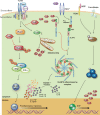Small Heterodimer Partner and Innate Immune Regulation
- PMID: 26754583
- PMCID: PMC4803555
- DOI: 10.3803/EnM.2016.31.1.17
Small Heterodimer Partner and Innate Immune Regulation
Abstract
The nuclear receptor superfamily consists of the steroid and non-steroid hormone receptors and the orphan nuclear receptors. Small heterodimer partner (SHP) is an orphan family nuclear receptor that plays an essential role in the regulation of glucose and cholesterol metabolism. Recent studies reported a previously unidentified role for SHP in the regulation of innate immunity and inflammation. The innate immune system has a critical function in the initial response against a variety of microbial and danger signals. Activation of the innate immune response results in the induction of inflammatory cytokines and chemokines to promote anti-microbial effects. An excessive or uncontrolled inflammatory response is potentially harmful to the host, and can cause tissue damage or pathological threat. Therefore, the innate immune response should be tightly regulated to enhance host defense while preventing unwanted immune pathologic responses. In this review, we discuss recent studies showing that SHP is involved in the negative regulation of toll-like receptor-induced and NLRP3 (NACHT, LRR and PYD domains-containing protein 3)-mediated inflammatory responses in innate immune cells. Understanding the function of SHP in innate immune cells will allow us to prevent or modulate acute and chronic inflammation processes in cases where dysregulated innate immune activation results in damage to normal tissues.
Keywords: Immunity, innate; Inflammasomes; Inflammation; SHP orphan nuclear receptor; Social control, formal; Toll-like receptors.
Conflict of interest statement
Figures

Similar articles
-
Mechanisms and pathways of innate immune activation and regulation in health and cancer.Hum Vaccin Immunother. 2014;10(11):3270-85. doi: 10.4161/21645515.2014.979640. Hum Vaccin Immunother. 2014. PMID: 25625930 Free PMC article. Review.
-
Emerging roles of orphan nuclear receptors in regulation of innate immunity.Arch Pharm Res. 2016 Nov;39(11):1491-1502. doi: 10.1007/s12272-016-0841-6. Epub 2016 Oct 4. Arch Pharm Res. 2016. PMID: 27699647 Review.
-
Small heterodimer partner interacts with NLRP3 and negatively regulates activation of the NLRP3 inflammasome.Nat Commun. 2015 Feb 6;6:6115. doi: 10.1038/ncomms7115. Nat Commun. 2015. PMID: 25655831 Free PMC article.
-
Structure and function of the atypical orphan nuclear receptor small heterodimer partner.Int Rev Cytol. 2007;261:117-58. doi: 10.1016/S0074-7696(07)61003-1. Int Rev Cytol. 2007. PMID: 17560281 Review.
-
Small Heterodimer Partner Controls the Virus-Mediated Antiviral Immune Response by Targeting CREB-Binding Protein in the Nucleus.Cell Rep. 2019 May 14;27(7):2105-2118.e5. doi: 10.1016/j.celrep.2019.04.071. Cell Rep. 2019. PMID: 31091449
Cited by
-
Natural products modulate NLRP3 in ulcerative colitis.Front Pharmacol. 2023 Oct 2;14:1265825. doi: 10.3389/fphar.2023.1265825. eCollection 2023. Front Pharmacol. 2023. PMID: 37849728 Free PMC article. Review.
-
Small Heterodimer Partner Modulates Macrophage Differentiation during Innate Immune Response through the Regulation of Peroxisome Proliferator Activated Receptor Gamma, Mitogen-Activated Protein Kinase, and Nuclear Factor Kappa B Pathways.Biomedicines. 2023 Aug 28;11(9):2403. doi: 10.3390/biomedicines11092403. Biomedicines. 2023. PMID: 37760844 Free PMC article.
-
Cholangiocyte-derived exosomal long noncoding RNA H19 promotes cholestatic liver injury in mouse and humans.Hepatology. 2018 Aug;68(2):599-615. doi: 10.1002/hep.29838. Epub 2018 May 2. Hepatology. 2018. PMID: 29425397 Free PMC article.
-
The Orphan Nuclear Receptor Gene NR0B2 Is a Favorite Prognosis Factor Modulated by Multiple Cellular Signal Pathways in Human Liver Cancers.Front Oncol. 2021 May 14;11:691199. doi: 10.3389/fonc.2021.691199. eCollection 2021. Front Oncol. 2021. PMID: 34055653 Free PMC article.
-
Farnesoid X Receptor Activation Protects Liver From Ischemia/Reperfusion Injury by Up-Regulating Small Heterodimer Partner in Kupffer Cells.Hepatol Commun. 2020 Feb 13;4(4):540-554. doi: 10.1002/hep4.1478. eCollection 2020 Apr. Hepatol Commun. 2020. PMID: 32258949 Free PMC article.
References
-
- Germain P, Chambon P, Eichele G, Evans RM, Lazar MA, Leid M, et al. International Union of Pharmacology. LXIII. Retinoid X receptors. Pharmacol Rev. 2006;58:760–772. - PubMed
-
- Gronemeyer H, Gustafsson JA, Laudet V. Principles for modulation of the nuclear receptor superfamily. Nat Rev Drug Discov. 2004;3:950–964. - PubMed
-
- Ranhotra HS. The orphan estrogen-related receptor alpha and metabolic regulation: new frontiers. J Recept Signal Transduct Res. 2015;35:565–568. - PubMed
-
- Seol W, Choi HS, Moore DD. An orphan nuclear hormone receptor that lacks a DNA binding domain and heterodimerizes with other receptors. Science. 1996;272:1336–1339. - PubMed
Publication types
LinkOut - more resources
Full Text Sources
Other Literature Sources

